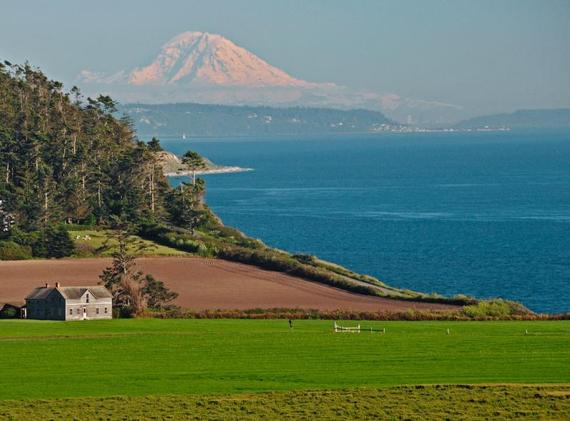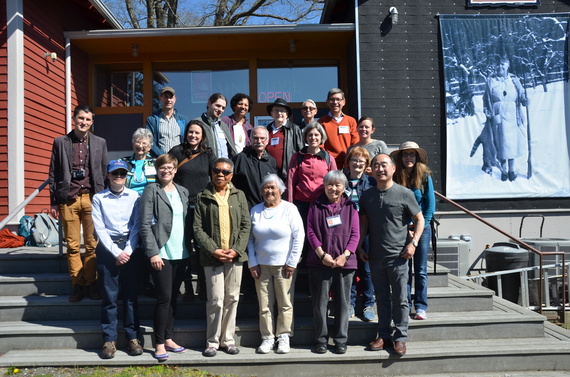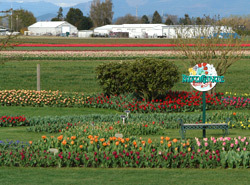Like a lover surprised by new ardor in a partner of many years, the 176th and 177th units of the National Park System I visited last weekend left me completely stunned by their unexpectedness.
At Bainbridge Island Japanese American Exclusion Memorial I stood on sacred ground where members of Japanese families who had been exiled by our government returned to an ebullient welcome from their neighbors, and survive to show us around the museum commemorating their history. At Ebey's Landing National Historical Reserve I looked out over almost 1800 acres of working farmland in a fertile valley between mountains and sea, collaboratively conserved by descendants who refused to cede to development pressures.
Front row from right, Clarence Moriwaki, a leading force in the creation of the Memorial stands beside Lilly Kodama and her sister Frances Ikegami, who were children when their families were forced to move from Bainbridge Island into an internment camp led the tour with visiting members of the American Society for Environmental History. Gerard Fitzgerald photo.
My passion for our National Park System reached new heights, and I can only give thanks for the impetus to protect the 409-unit system that contains our expansive heritage. I can hardly wait to see what surprises are in store at the other 232 units, and I hope by the time I've gotten to them all, we will have added another 200 units that reflect our natural, historical and cultural legacies. (Hear that, President Obama?)
The entire trip to Seattle was like an orgy of indulgence. Where else might one see the towering snow-clad peak of Mount Rainier on one side and the turgid bulk of Mt. Baker on the other? The placid waters of Puget Sound dotted with islands such as Bainbridge and Whidbey, where Ebey's Landing is located, combine in a smorgasbord for the senses, only exacerbated by the stories we were told. Being able to enjoy them in the company of our "son" James King II - a stalwart park leader following in our footsteps, and members of the American Society for Environmental History from all over the country, was just a treat for the soul.
This heinous reminder from our not-so-distant past is increasingly relevant today in the face of heated "exclusion" rhetoric from some of our leading contenders for president.
These two parks put a fine point on the peril and opportunity confronting our country: the push toward oppression of our fellow citizens on the basis of racial, ethnic, economic and geographic differences, and the tendency toward overdevelopment that ends up reducing unique landscapes to a cookie-cutter similarity. The Exclusion site emphasizing Nidoto Nai Yoni - let it not happen again should be an object lesson for our culture as we listen to aspirants for the highest office in the land propose the forcible removal of our countrymen and women. The Reserve shows that we can protect those traditions we hold dear, and upon leaving Ebey's Landing we passed through a community that is looking to use Ebey's model of conservation to protect their farming heritage.
At the Bainbridge Island Historical Museum we walked through history led by Lilly Kodama who was 7 years old on March 30, 1942 when her family was removed and her sister Frances Ikegami who was 5 at the time. My heart was gladdened by the stories they related about community members who dedicated themselves to keeping the memory of their exiled neighbors alive in their absence, some even paying the property taxes so that the excluded people could retain their homes.
At the eerily beautiful memorial made of solid red cedar in a curving wall containing the names and ages of each excluded family member, one of the lead organizers Clarence Moriwaki told us a story that made my hair stand on end.
"On the 60th anniversary of the exclusion we gathered here March 30, 2002 to read the names of the excluded people," he began. " Then the crows started calling. More and more crows arrived and perched on the trees surrounding us. Their cawing got so loud it practically drowned out the sound system. When we came to the last name, the cawing stopped as suddenly as it began and the crows all flew away. It would be hard to believe except that when we checked the recording, the crows clearly began cawing at the first name and ended on the last."
It makes utter sense to me to learn that the region's indigenous people consider crows to be the spirit of their ancestors.
At Ebey's Landing, a sparrow flew into the bus where I was sitting alone, requiring me to pick it up and take it outdoors as a bald eagle flew overhead, a rabbit in its talons.
"Past meets present in this working rural landscape and community," notes the park's brochure. "Created by Congress in 1978, the 17,572-acre Reserve integrates historic farms, a seaside town, native and pioneer land use traditions, and ecologically significant areas. "

No one photograph can possibly do justice to the spacious diversity of Ebey's Landing parkscape, but this one with Mt. Rainier in the distance comes John Chao photo.
The park is managed by a Trust Board that includes representatives of the local town and county, Washington State Parks and the National Park Service. This model that does not even include a title of "Superintendent," has survived intact for 28 years. I heartily congratulated Reserve Manager Kirsten Griffin on the dexterity and diplomacy with which she coordinates these multiple combined interests.
The story of the fate of Isaac Ebey, the pioneering settler who was the first to claim land under the Donation Land Law of 1850 also gave me the chills. From all accounts an upright and fair gentleman, he became the ultimate scapegoat and paid with his life for a crime that was no fault of his own. In 1857 when members of the Haida Indian tribes came looking for a " chief" to kill in retaliation for one of their chiefs killed the year before by American forces, locals pointed to Ebey as the leader of the settlement. He was summarily executed.
On our way back from Ebey's to Seattle we passed through Anacortes at the height of the Annual Tulip Festival, driving past field and fields of tulips in multiple colors planted in neat expanding rows, the American version of the original tulip festival we saw in Holland a few years ago. If only we could dedicate ourselves to find solutions that help the hundreds of apparently homeless people I saw on the streets, I might say that the profusion of national parks and recreation areas I experienced in Seattle made me feel that I was in Paradise on Earth.




